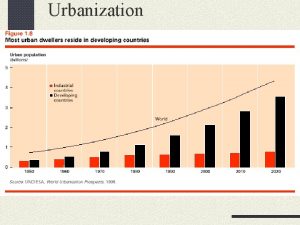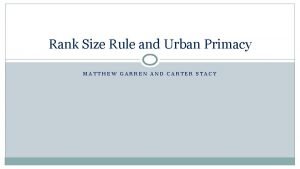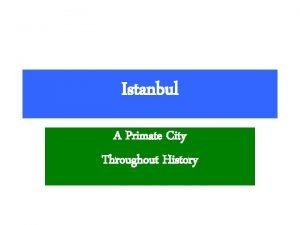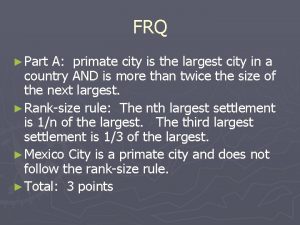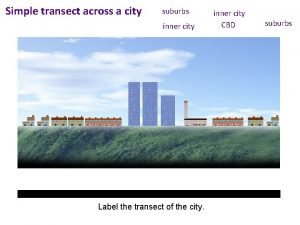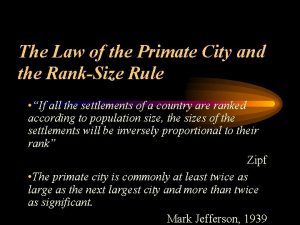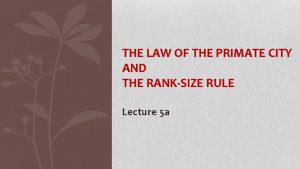The Law of the Primate City and the

















- Slides: 17

The Law of the Primate City and the Rank-Size Rule • “If all the settlements of a country are ranked according to population size, the sizes of the settlements will be inversely proportional to their rank” Zipf • The primate city is commonly at least twice as large as the next largest city and more than twice as significant. Mark Jefferson, 1939

The City of Angels FACTOIDS • Capital city for more than 200 years • Registered population of over 5. 5 million (Estimated actual population of up to 8 million) • 1, 568 sqkm area • Growth started recently, in the fifties and sixties

Bangkok – Example of a Primate City • Urban Primacy - where the largest city is many times larger than the second city. • A huge dichotomy exists between Bangkok (5. 9 million) and Thailand's second city, Nakhon Ratchasima (278, 000).

Examples of Countries With Primate Cities • • • France UK Mexico Thailand Argentina Romania

The United Kingdom

Factors Encouraging Primacy • Favorable initial advantages for site • Advantages maintained and enhanced • Magnetic attraction for businesses, services and people (cumulative effect) • Disproportionate growth increases attractiveness • Has a parasitic effect, sucking wealth, natural and human resources.

For & Against Primate Cities in an LDC like Bangkok FOR • They attract overseas investment and benefits that will eventually benefit the whole country AGAINST • They are unstoppable monsters that create serious problems, shortages and escalating land prices that make them less attractive places to live in.

Urban Problems In Bangkok • • • Flooding Refuse Transport Recreation Pollution Poor Planning Finance Conflicting demands Rapid urbanization

Examples of Countries that Lack Primate Cities • • • India U. S. A. China Canada Australia Brazil

Rank Size Rule - Zipf • If all cities in a country are placed in order from the largest to the smallest, each one will have a population half the size of the preceding city.

Theory of Rank-Size Rule • George Zipf – 1949 “The second and subsequently smaller cities represent a proportion of the largest city”. (Explains the size cities in a country)






Discuss THREE ways in which the concept of core-periphery relations helps explain the development of the urban systems shown above. Be sure to use evidence from both maps to support your conclusions.
 Primate cities
Primate cities Law of primate city
Law of primate city Is london a primate city
Is london a primate city What does rank size rule mean
What does rank size rule mean What is rank size rule
What is rank size rule Is istanbul a primate city
Is istanbul a primate city Primate city frq
Primate city frq The arrangement of a phenomenon across earth's surface is
The arrangement of a phenomenon across earth's surface is Newton's first law and second law and third law
Newton's first law and second law and third law Si unit of newton's first law
Si unit of newton's first law V=k/p
V=k/p Avogadro's law constant
Avogadro's law constant History of latin american city model
History of latin american city model Hoyt model
Hoyt model Primate evolution tree
Primate evolution tree Primates characteristics
Primates characteristics Primate suite of traits
Primate suite of traits Chapter 16 primate evolution study guide answer key
Chapter 16 primate evolution study guide answer key
